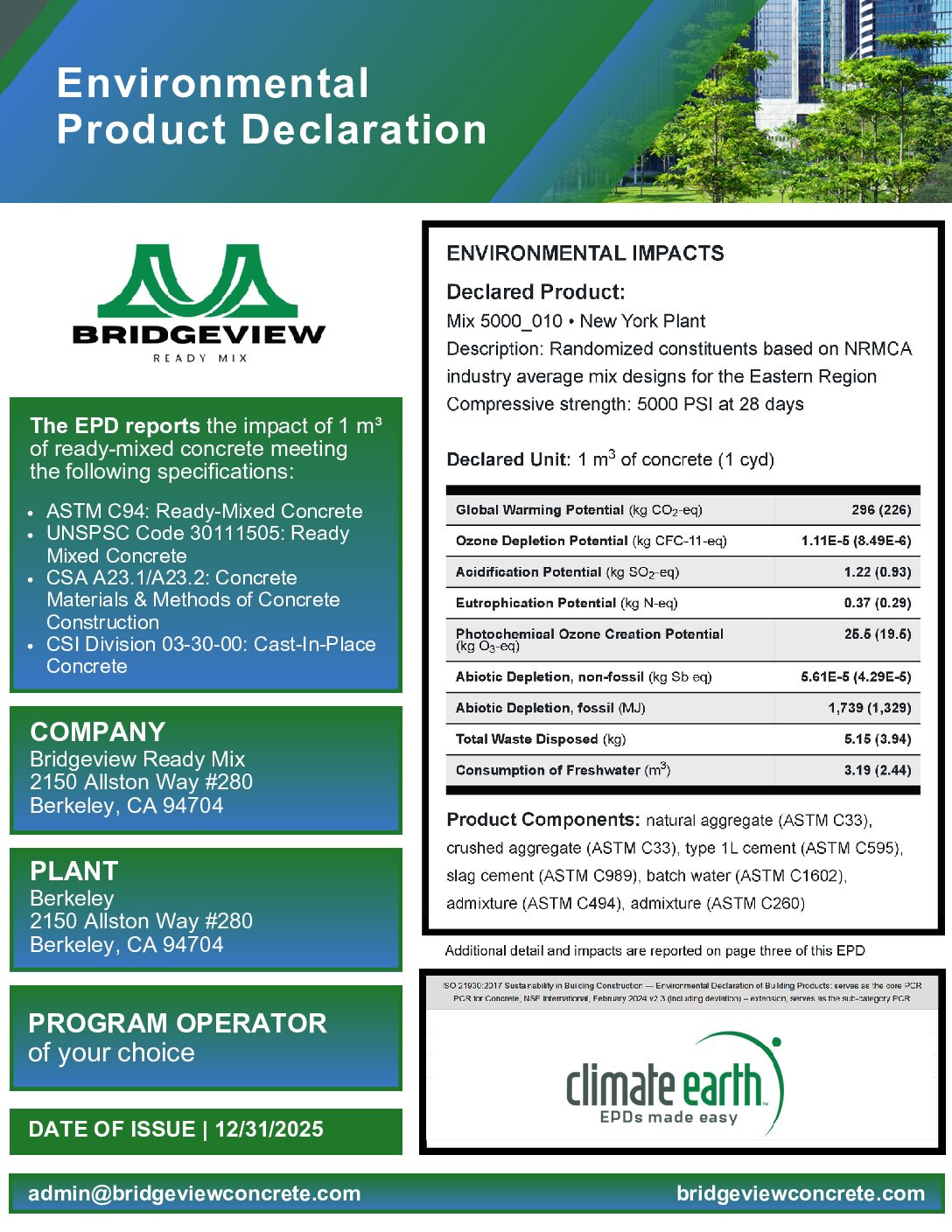EPD 101
What is an EPD?
What Is an EPD? The 2025 Guide to Concrete EPDs
You’ve heard about EPDs. Maybe you’ve filed a few to meet a spec or keep a project moving. But in 2025, concrete EPDs (Environmental Product Declarations) aren’t just another checkbox.
They’re the difference between winning the work or watching it go to someone else. They’re now central to what it takes to win, keep, and grow your concrete business.
What you’ll get from this guide:
- What a concrete EPD really is and why it matters for your business in 2025
- How EPDs help you win work, stay compliant, and avoid costly mistakes
- Step-by-step: how to create, verify, and submit EPDs the right way
- Answers to the top EPD questions concrete producers are asking right now (in our quick-hit FAQ)
Define EPD: What Is an EPD?
An EPD, or Environmental Product Declaration, is a verified document. It shows the environmental impact of a product, like concrete, throughout its life cycle.
Why does this matter in concrete?
A concrete EPD is now the industry standard for communicating how “green” your mix is. Helping you meet market demands, win bids, and prove compliance with everything from LEED v4/v5, to Buy Clean, to CPR/Digital Product Passports.
It’s not just a sustainability label. An EPD provides project owners, contractors, and specifiers reliable data on carbon emissions and resource use. We customize this data to fit your specific needs.
Why EPDs Matter in Concrete: More Than Just “Tree Hugging”
If you’re in concrete, you know the rules keep changing. EPDs can feel like another hoop to jump through. But the real winners treat EPDs as more than paperwork. They use them as a tool to get ahead.
Here’s what EPDs do for your business:
- 📑 Stronger Reporting: EPDs provide credible numbers for every mix—critical for submittals, audits, and meeting owner or DOT requirements.
- 🏗️ Smarter Mix Management: Track and compare the environmental impact of each mix. Optimize designs and find savings, whether in cost or carbon.
- 💸 Bidding Advantage: Back up your value with real, verified data. More projects now require EPDs just to qualify.
- 🚀 Faster Innovation: Mix-specific EPDs show you where to improve. This includes using SCMs, reducing cement, or changing your supply chain.
- 📈 More Than Compliance: EPDs support public jobs (Buy Clean, LEED, CPR), and day-to-day operations—fueling growth, not just checking boxes.
Treat EPDs like a business tool, not red tape. The right approach turns EPDs into your edge for more work, smarter operations, and staying ahead as regulations shift.
What Does a Concrete EPD Actually Measure?
When you look at a concrete EPD, you’re seeing third-party verified data covering:
- Global Warming Potential (GWP) measures total greenhouse gas emissions. It is reported as carbon dioxide equivalent (CO2-eq) per cubic meter or cubic yard of concrete.
- Resource and Raw Material Use: This includes using fresh water, fossil and non-fossil minerals. It also covers primary resources used for materials and fuels, as well as secondary or recovered materials and fuels.
- Waste and Emissions: Hazardous, non-hazardous, and recycled waste streams created through plant operations .
Every credible EPD follows standards like ISO 14025, ISO 21930, and EN 15804. It also meets specific Product Category Rules (PCR) for different regions. This ensures that the data is clear and can be compared easily.
How Do You Make a Concrete EPD?
A concrete EPD is like a nutrition label for your mix. It shows the carbon footprint, energy use, water use, and other impacts.
Here’s how you get it done, step by step:
- Gather Your Mix Data: What’s in your mix—cement, SCMs, aggregates, admixtures, water—and how much. Use the real batch ticket, not an average.
- Track Plant Operations: Record plant-related energy use (electricity, fuel), water use, and transportation in the upstream supply chain.
- Use Concrete-Specific EPD Software to conduct a Life Cycle Assessment (LCA): Don’t rely on generic LCA tools. Use software that connects to your batch data and that someone built for concrete.
- Get It Third-Party Verified: An independent verifier checks your data, the LCA, and results. This ensures that each step meets the right standards. Without this step, your EPD isn’t credible.
- Submit and Share: Once verified, you get a certified EPD for your mix. Attach it to bids and submittals to show exactly what owners and contractors are getting.
Bottom line: If you can run a plant and fill out a batch ticket, you can make an EPD. The right software and verifier make it fast, accurate, and accepted everywhere.
Third-Party Verification: Who Checks Concrete EPDs?
If you don’t independently verify your EPD, you might as well treat it like a marketing flyer. Third-party verification shows that your numbers are real. This helps project owners, DOTs, and green building programs trust your data. Key verification bodies (aka Program Operators) by region:
- USA: NRMCA, ASTM, EPD North America
- Europe: IBU, EPD International
- Latin America: National programs aligned with EPD International, IBU, or European operators
- Asia: EPD International, local verified programs
Verification is key for credibility. The right partner will guide you through data collection, help you meet every requirement, and keep your EPDs accepted and up to date.
EPDs in 2025: The Reality for Concrete Producers
Let’s be clear. EPDs aren’t just about sustainability. They’re central to how you win work, manage your mix portfolio, and stay competitive. In 2025, EPDs are shaping the future of concrete—ready or not.
The Hard Truth in the Numbers
- 🌍 Global study shows 80% say Environmental Product Declarations shape AEC purchasing decisions (Architectural Ironmongery Journal).
- 💸 Global EPD market is projected to grow from $1.9B to $4.2B by 2028 (Archive Market Research, 2025).
- 🏗️ Global data center construction is surging toward $243B in 2025. Project owners increasingly require EPDs for prequalification.
Today’s winners aren’t just greener. They’re smarter. If you’re still chasing one-off reports while competitors have instant, mix-specific EPDs, you’re already behind.
Case Studies: How Top Producers Win with EPDs
The best concrete producers use EPDs to drive innovation, outbid competitors, and take market share. Here’s what’s working:
- 🧠 Amrize: Created a full catalog of mix-specific, verified EPDs. Enabled AI-driven optimization and won a Meta data center project by hitting strict performance and carbon targets.
- 🌍 Holcim: Scaled digital EPDs globally, supporting products like ECOPact®, achieving up to 30% CO₂ reductions and winning high-performance, low-carbon projects.
- 🏆 National Ready Mixed Concrete Co.: Built a plant-wide EPD program, experimented with 1L/CEM I cement and custom low-emission fleets, and became a regional leader by offering job-specific EPDs on demand.
Common Pitfalls When Creating Concrete EPDs
Navigating EPDs can be a minefield. Miss a detail and you risk rejections, lost bids, or hours of back-and-forth.
Biggest mistakes to avoid:
- ⚠️ Using generic or template EPDs: These rarely meet LEED, Buy Clean, or PCR rules.
- 1️⃣ Get one EPD at a time: Instead, find a provider who can organize the LCA for your entire plant. This will make the process more efficient and give you unlimited, mix-specific EPDs.
- 🕰️ Relying only on consultants can be a problem. Many are slow or do not understand plant realities. This can leave you with outdated data or late reports.
- 🖥️ Choosing software that isn’t concrete-specific: Most generic tools can’t connect to batch data and waste your time.
- 📉 Missing key data: Forgetting things like transportation distances or plant energy leads to rejections.
- 🙅 No concrete experts in support: Some platforms leave you on your own with no practical help.
Avoid these by making your EPDs mix-specific, up to date, and backed by real concrete experts.
What to Look For in EPD Vendors: Set Yourself Up for Success
Tired of EPD headaches? Here’s what to demand from your EPD partner or platform:
- 🏗️ Mix-Specific, Batch-Ready EPDs: Get EPDs for every mix. Not just plant averages. Be ready for instant submittals, public jobs, and spec changes.
- 🔗 Seamless Data Integration: Your EPD tool should link directly with batch/QC software or ERP. Automatic, accurate, up-to-date reporting.
- 🤝 Real Concrete Experts: You want people who know batch plants, labs, and jobsite demands. Not just generic software support.
- 📄 Fast, Trusted Third-Party Verification: Your vendor should make it easy to get verified EPDs (NRMCA).
- 📊 Strong Reporting and Carbon Tracking: Instantly pull reports by project, plant, or mix for audits, owners, and GCs.
- 🚀 Innovation Tools: Use your EPD system to model new mix designs and spot opportunities for lower carbon or cost.
- 🎓 Training That Fits Concrete: Skip vendors who make you take endless generic EPD courses. Obtain practical support and training designed around the actual process of making concrete.
If you want EPDs that help you win bids, innovate, and deliver what the market demands, don’t settle for generic solutions.
Concrete EPD FAQ
Are concrete EPDs required now?
Yes. Most public projects (federal, state, and EU), plus LEED and Buy Clean jobs, require EPDs for bidding and compliance. (USGBC LEED, Buy Clean)
How long is a concrete EPD valid?
Usually five years, unless you change your mix or plant process.
What’s the difference between an industry-average EPD and a product-specific EPD?
Industry-average = generic. Product-specific = your plant, your mix. Only product-specific EPDs count for full LEED and Buy Clean credits.
Do EPDs prove my concrete meets performance spec?
No. EPDs show environmental data, not strength or slump. Always submit both EPDs and technical data sheets. There should be no proprietary data on your EPD.
How do EPDs relate to LCAs?
An EPD is the published, third-party verified result of a Life Cycle Assessment (LCA) for your product.
Will EPDs help me win work?
Yes. EPDs are now a must-have for pre-qualification and often tip the scale when owners want real, verified proof.
Still have questions? Reach out to our team for answers.

